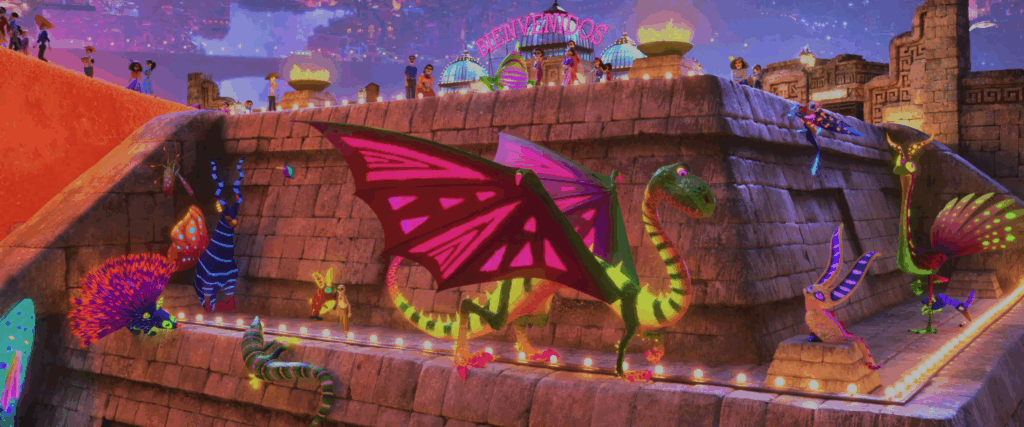The alebrijes are brightly colored, imaginative creatures that mix features from many animals such as dragons, lizards, roosters, and butterflies. These hybrid figures are covered in intricate patterns and intense colors that reflect the vibrant spirit of Mexican folk art.
Originally made with papier-mâché, they later evolved into wood carvings, becoming one of Mexico’s most beloved artistic symbols.

History and Origins
The origin of alebrijes goes back to Mexico City in the 1930s, when a cartonero (papier-mâché artisan) named Pedro Linares López began creating fantastic creatures inspired by a vivid dream.
While sick with a high fever, he imagined himself walking through a strange forest filled with hybrid animals that cried out the word “alebrijes.” When he recovered, he brought his dream to life using paper, cardboard, and paste, the materials he already used to make judas and piñatas.
Another version of the story mentions the painter José Gómez Rosas, known as El Hotentote, who asked Linares to make surreal creatures for a masquerade at the San Carlos Arts Academy. In either version, Linares combined imagination, symbolism, and traditional craft to create something entirely new.
His pieces caught the attention of well-known artists such as Frida Kahlo and Diego Rivera, who became collectors of his work. In 1975, filmmaker Judith Bronowski released the documentary Pedro Linares: Artisan of Fantasy, which introduced the alebrijes to the world. Linares later received Mexico’s National Prize for Popular Arts and Traditions in 1990 and continued working until his death in 1992.
How Alebrijes Are Made
Papier-Mâché Alebrijes

The original technique used by Pedro Linares is still practiced by artisans in Mexico City. The process usually includes:
- Creating the structure with wire, reeds, or newspaper rolls.
- Covering the base with layers of pasted paper to form a solid shape.
- Sanding and detailing once the piece dries completely.
- Painting with bright acrylic colors, dots, and geometric lines.

Each figure is hand-painted and completely unique. The Linares family continues this tradition in La Merced, keeping the art alive for new generations.
Wood-Carved Alebrijes
In the state of Oaxaca, the idea of alebrijes found new life through Manuel Jiménez of Arrazola, who began carving fantastic animals out of copal wood during the 1960s. His work inspired other artisans to do the same, giving rise to an entire tradition of colorful, hand-carved figures.

The process involves selecting the right branch of copal, carving it with machetes and knives, drying it, applying a base coat, and painting it with small brushes using thousands of tiny dots and lines. Each workshop develops its own patterns, inspired by local Zapotec culture and by the concept of tonas and nahuales, animal spirits that protect each person.
Alebrijes Through Time (Timeline Infographic)
| Year | Event |
| 1930s | Pedro Linares creates the first papier-mâché alebrijes in Mexico City. |
| 1940s–60s | Artists and collectors promote Linares’s work among Mexico’s art circles. |
| 1975 | Judith Bronowski’s documentary spreads the art internationally. |
| 1990 | Linares receives the National Folk Art Prize. |
| 1960s–1970s | Manuel Jiménez pioneers the Oaxacan wood-carving style. |
| 2007 | The Museo de Arte Popular in Mexico City starts La Noche de los Alebrijes, a parade of giant creatures. |
Alebrijes Today
Each October, the streets of Mexico City come alive during La Noche de los Alebrijes, when enormous illuminated creatures parade from the Angel of Independence to the Zócalo. More than 200 artists and collectives participate, accompanied by music, storytelling, and performances that celebrate creativity and imagination.
Meanwhile, in Oaxaca, workshops in San Martín Tilcajete and Arrazola welcome visitors who wish to see how the figures are carved and painted. Many families, including the descendants of Manuel Jiménez, continue to pass down their skills and create new designs every year.
Alebrijes also reached international audiences through the 2017 Disney-Pixar film Coco.

Although the film’s colorful spirit animals were inspired by alebrijes, they were reimagined as guides in the Land of the Dead rather than as traditional folk art figures.
The movie’s popularity helped renew global interest in Mexican craftsmanship and introduced millions of viewers to this unique artistic tradition.
Symbolism and Meaning
Alebrijes are more than decorative art pieces. They are expressions of imagination, identity, and protection.
Their animal combinations often represent transformation and connection between the natural and spiritual worlds.
Colors also carry meaning:
- Green represents nature and renewal.
- Red symbolizes strength and passion.
- Blue expresses spirituality and calm.
- Yellow stands for joy and creativity.
Every artisan develops a personal language of color and pattern, turning each alebrije into a reflection of individual vision and regional heritage.
Where to See Alebrijes
- Museo de Arte Popular (Mexico City): Permanent exhibitions and organizer of La Noche de los Alebrijes.
- San Martín Tilcajete and Arrazola (Oaxaca): Artisan towns known for workshops and galleries.
- La Ciudadela Market (Mexico City): One of the best places to buy authentic folk art directly from artisans.
- Museums Abroad: Several international museums of Latin American art hold original works by Pedro Linares and other master artisans.
Conclusion
From the dreams of Pedro Linares to the hand-carved sculptures of Oaxacan artisans, alebrijes have evolved into a living symbol of Mexican creativity.
They represent the fusion of imagination and tradition, linking the mystical with the handmade. Whether molded from paper or carved from wood, these fantastic creatures continue to inspire wonder, connecting Mexico’s past, present, and artistry through color and form.







Leave a Reply